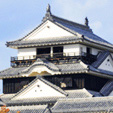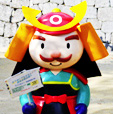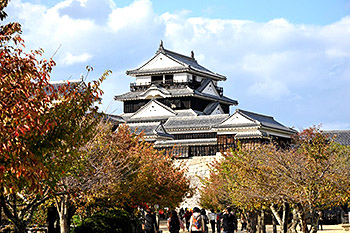本文
A trip to the sites relating to the epic novel " Saka-no-Ue-no-Kumo (Clouds above the Hill)"




 Matsuyama Castle
Matsuyama Castle
This castle that towers over the center of Matsuyama is the symbol of the city.
This castle that towers over the center of Matsuyama is the symbol of the city. It is one of 12 extant castle towers*1 in Japan, as well as one of the three biggest interconnected-style castles*2 on hills. Its twenty-one buildings are nationally designated as an important cultural property.
*1 The main castle tower was constructed in, or before, the Edo period and has not been rebuilt.
*2 The interconnected-style castle has a main building with one or more secondary towers connected each other. The other two extant interconnected-style castles are Himeji and Wakayama.

Access to the main castle tower is via a footpath, cable car, or chair lift. At the entrance to the castle, you will be welcomed by the cartoon mascot Yoshiaki-kun, who is based on the first lord of Matsuyama Clan, Yoshiaki Kato. Feel free to have your picture taken with him! From the castle there is a magnificent panoramic view of Matsuyama Plain.

Open hours
Castle tower 9時00分-17時00分(It changes according to a season.)
Price
Ropeway Lift: Adult/ 500yen, Child/ 250yen
Castle tower: Adult/ 500yen, Child/ 150yen
Parking lot
26 cars(Charge)
Address
1,Marunouchi,Matsuyama city(Castle tower)
Contact information
Telephone number 089-921-4873
Website
http://www.matsuyamajo.jp/(External link)<外部リンク>
matsuyamajo@iyotetsu.co.jp
About 20 minutes(On Foot)
 Saka-no-Ue no Kumo Museum
Saka-no-Ue no Kumo Museum
The content of this museum is based around the literary work "Saka-no-Ue no Kumo (The Cloud Above the Hill)" by Ryotaro Shiba.
The content of this museum is based around the literary work ""Saka-no-Ue no Kumo(The Cloud Above the Hill)"" by Ryotaro Shiba. Meiji era artifacts of the real-life main characters, the Akiyoshi brothers Yoshifuru and Saneyuki and poet Shiki Masaoka, are also on display. The building is designed by Tadao Ando.*
* An internationally renowned Japanese contemporary architect, born in Osaka.

The permanent collection includes a number of fascinating objects from the period in which the novel Saka-no-Ue no kumo is set. In the space on the fourth floor, the exhibition changes from year to year. In the cafe on the second floor, visitors can take a break with a bird's-eye view of Matsuyama.

Open hours
9時00分-18時00分(closure Monday)
Price
Adult/ 400yen, High school student/ 200yen
junior high school student and younger/ Free
Parking lot
5 cars(For the handicapped)
Address
3-20,Ichiban-cho,Matsuyama city
Contact information
Telephone number 089-915-2600
Fax number 089-915-3600
Website
http://www.sakanouenokumomuseum.jp/(External link)<外部リンク>
sakakumo-museum@yon-b.co.jp
About 3 minutes(On Foot)
 Bansuisou
Bansuisou
This French mansion was built as a villa in 1922 by Count Sadakoto Hisamatsu, descendent of the former lord of Matsuyama.
This French mansion was built as a villa in 1922 by Count Sadakoto Hisamatsu, descendent of the former lord of Matsuyama. It was nationally designated as an important cultural property on November 29, 2011. The free shuttle bus called Matsuyama Madonna Bus which starts and finishes at a stop of Bansuisou was launched on April 1, 2012, to make Matsuyama sightseeing more convenient. (Bansuisou bus stop does not operate outside of opening hours.)

Open hours
9時00分-18時00分(closure Monday)Monday opens a public holiday.
Price
Adult/ 100yen
High school and College student/ 50yen
Schoolchild and Junior high school student/ Free
Parking lot
About 40 cars
Address
3-7, Ichiban-cho, Matsuyama city
Contact information
Telephone number 089-921-3711
Website
http://www.bansuisou.org/(External link)<外部リンク>
-
About 10 minutes(By Car)
 Shiki Do
Shiki Do
In the Meiji era, haiku poet Shiki Masaoka lived here up to the age of seventeen.
In the Meiji era, haiku poet Shiki Masaoka lived here up to the age of seventeen. The living and study rooms, which he used during that time, have been restored to how they would have appeared in the Meiji era. Included in the rooms are Shiki Masaoka's desk and photos, and his calligraphy and paintings.

Thanks to a loving restoration of the Masaoka house, you might get the impression that you are a guest of the family. The soul of the poet Shiki Masaoka lingers on through the display of his favorite objects and belongings. In the grounds of the house is a stone tablet engraved with a commemorative haiku, and a stone pagoda which contains a locket of his hair. A visit to the house is a must for anyone with an interest in Shiki Masaoka or haiku poetry.

Open hours
8時30分-17時00分(With no closure)
Price
Adult/50yen
High school and College student/ 40yen
Schoolchild and Junior high school student/ 30yen
Parking lot
About 20 cars
Address
16-3,Suehiromachi,Matsuyama city
Contact information
Telephone number 089-945-0400
Website
-
-

 Matsuyama Municipal Shiki Memorial Museum
Matsuyama Municipal Shiki Memorial Museum
This literary museum aims to familiarize visitors with Matsuyama through the world of Shiki Masaoka.

This literary museum aims to familiarize visitors with Matsuyama through the world of Shiki Masaoka. Promoting a deeper knowledge and understanding of the traditional culture and literature of Matsuyama, the museum hopes to contribute to the development of new culture. A popular tourist spot, the museum located in the Dogo district.

"We provide lectures and host nationwide competitions of haiku(17 syllable poems) and tanka(31 syllable poems)."

Open hours
9時00分-17時30分(From May 1 to October 31)
9時00分-16時30分(From November 1 to April 30)
Price
Adult/400yen
Child/Free
Parking lot
22 cars(Charge)
Address
1-30,Dogo-Koen,Matsuyama city
Contact information
Telephone number 089-931-5566
Fax number 089-934-3416
Website
http://sikihaku.lesp.co.jp/(External link)<外部リンク>
sikihaku@lesp.co.jp

GoogleMaps(External link)<外部リンク>



Birthplace of Akiyama Brothers
Located to the east of Shiroyama. Yoshifuru*1 lived here up to the age of 16, and Saneyuki*2 until he was 15. The house was destroyed by bombing during WWII, though has been rebuilt faithful to the original, based on old photos, archive documents, and oral history.
*1 Senior officer in the Imperial Japanese Army during the Russo-Japanese War.
*2 Senior officer in the Imperial Japanese Navy during the Russo-Japanese War.


Cemetery of Russian Soldiers
During the Russo-Japanese War, the first internment camp of Russian soldiers in Japan was built in Matsuyama. It accommodated over 4,000 prisoners of war (POW) at its height. The prisoners were allowed to live rather freely and often interacted with the locals. The cemetery is situated on a calm hill, north of the castle, where the POWs have unfortunately found their final resting place in a foreign country. Local residents and junior-high school students still continue to tend to the upkeep of the graves.














